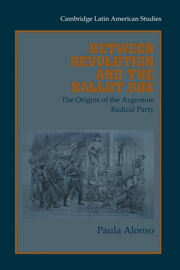Book contents
- Frontmatter
- Contents
- Acknowledgments
- List of Abbreviations
- List of Tables and Figures
- Introduction
- 1 The Political Arena
- 2 Mounting an Opposition
- 3 The Short-Lived Unión Cívica
- 4 The Radicals in Action: Part I
- 5 The Radicals in Action: Part II
- 6 The Decline of the Radical Party
- Conclusion
- Appendix 1 A Chronology of Political Parties and Factions, 1862–1910
- Appendix 2 Details of the Members of the National Committee of the UCR in 1892
- Appendix 3 Property Values in Buenos Aires, 1890–1898
- Bibliography
- Index
2 - Mounting an Opposition
Published online by Cambridge University Press: 05 August 2011
- Frontmatter
- Contents
- Acknowledgments
- List of Abbreviations
- List of Tables and Figures
- Introduction
- 1 The Political Arena
- 2 Mounting an Opposition
- 3 The Short-Lived Unión Cívica
- 4 The Radicals in Action: Part I
- 5 The Radicals in Action: Part II
- 6 The Decline of the Radical Party
- Conclusion
- Appendix 1 A Chronology of Political Parties and Factions, 1862–1910
- Appendix 2 Details of the Members of the National Committee of the UCR in 1892
- Appendix 3 Property Values in Buenos Aires, 1890–1898
- Bibliography
- Index
Summary
In late 1889, a group of politicians who objected to the course of events of the 1880s organized an opposition coalition called the Unión Cívica (UC). Based in the city of Buenos Aires, the UC was officially launched at a public meeting on 13 April 1890. The organization was primarily a political front for an attempt to overthrow President Juárez Celman (1886–1890); the revolution broke out in July 1890. The national government defeated the rebels, but the president was nevertheless forced to resign within days of the outbreak.
The organization of the UC, the meeting of 13 April, and the July Revolution have been the subject of much myth-making. These events have generally been described as a spontaneous uprising against the oligarchy by new social forces intent on creating a system of government involving the full participation of the people. The UC has been defined as the political party that led these “awakened social forces” and which, given the inequitable conditions of electoral competition, had little option but to organize an armed uprising. The UC itself has tended to be portrayed as a strongly organized political party with long-term objectives over and above the immediate overthrow of President Juárez Celman. As the Radical Party itself emerged in 1891 as a splinter group of the UC, it is important to follow the organization and trajectory of the UC closely. This chapter, therefore, begins by describing Juárez Celman's presidency and the events that triggered the organization in Buenos Aires city of a new opposition group.
- Type
- Chapter
- Information
- Between Revolution and the Ballot BoxThe Origins of the Argentine Radical Party in the 1890s, pp. 47 - 68Publisher: Cambridge University PressPrint publication year: 2000

